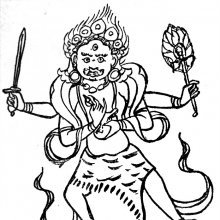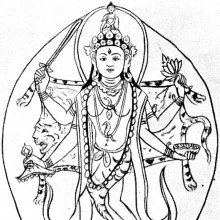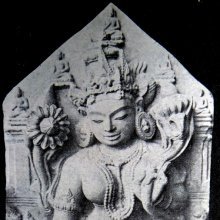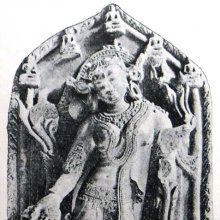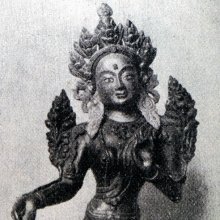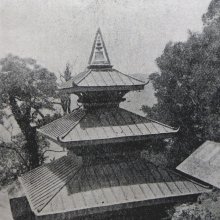Mahacinatara, Mahācīnatārā, Mahacina-tara: 1 definition
Introduction:
Mahacinatara means something in Buddhism, Pali. If you want to know the exact meaning, history, etymology or English translation of this term then check out the descriptions on this page. Add your comment or reference to a book if you want to contribute to this summary article.
Alternative spellings of this word include Mahachinatara.
Images (photo gallery)
In Buddhism
Tibetan Buddhism (Vajrayana or tantric Buddhism)
Source: archive.org: The Indian Buddhist IconographyMahācīnatārā (महाचीनतारा) refers to one of the female emanations of Akṣobhya, as mentioned in the 5th-century Sādhanamālā (a collection of sādhana texts that contain detailed instructions for rituals).—Her Āsana is the pratyālīḍha; her Appearance is terrible; her Vāhana is the corpse; she has four arms.—Mahācīnatārā is also known in Buddhist Tantric literature as Ugratārā, and the Vajrayogini temple at Śāṅku in Nepal, contains in the sanctum a figure of Ugratārā. This Ugratārā or Mahācīnatārā of the Buddhists has been incorporated in the Hindu pantheon under the name of Tārā, and is now regarded as one of the ten Mahāvidyā goddesses.
Mahācīnatārā is called Mahācīna Tārā because she is believed to have come from Mahācīna, the place where she was originally worshipped. She is the subject of the Mahācīnakrama-Tantra, and has been incorporated wholly into the Hindu Tantric pantheon. [...] Strictly speaking, only those deities can be called Tārās to whom the mantra: “oṃ tārā tuttāre ture svāhā” is assigned. [...] From the colour of the different Tārās it will be possible to refer them [viz., Mahācīnatārā] to their respective Kulas or families presided over by the five Dhyāni Buddhas.
The Dhyāna (meditation instructions) of Mahācīnatārā described in the Sādhanamālā as follows:—
“The worshipper should conceive himself as (Mahācīna-Tārā) who stands in the pratyālīḍha attitude, and is awe-inspiring with a garland of heads hanging from the neck. She is short and has a protruding belly, and her looks are terrible. Her complexion is like that of the blue lotus, and she is three-eyed, one-faced, celestial and laughs horribly. She is in an intensely pleasant mood, stands on a corpse, is decked in ornaments of snakes, has red and round eyes, wears the garments of tiger-skin round her loins, is in youthful bloom, is endowed with the five suspicious symbols, and has a protrudiug tongue. She is most terrible, appears fierce, with bare canine fangs, carries the sword and the kartri in the two right hands and the uptala and the kapāla in the two left. Her jaṭāmukuṭa of one coil is brown and fiery and bears the image of Akṣobhya within it”.
In the Tantrasāra of Kṛṣṇānanda Āgamavāgīśa an almost identical Dhyāna is stated describing a goddess of the name of Tārā. [...] A comparison of the two Dhyānas will at once reveal how the original composition of Śāśvatavajra has been modified in the Tantrasāra by a Hindu Tantric author. Some lines have been added to the original Dhyāna and all grammatical errors are rectified. This is evidently the recognized method of Hinduizing a Buddhist Tantric deity.

Tibetan Buddhism includes schools such as Nyingma, Kadampa, Kagyu and Gelug. Their primary canon of literature is divided in two broad categories: The Kangyur, which consists of Buddha’s words, and the Tengyur, which includes commentaries from various sources. Esotericism and tantra techniques (vajrayāna) are collected indepently.
See also (Relevant definitions)
Relevant text
Search found 1 books and stories containing Mahacinatara, Mahācīnatārā, Mahacina-tara, Mahācīna-tārā; (plurals include: Mahacinataras, Mahācīnatārās, taras, tārās). You can also click to the full overview containing English textual excerpts. Below are direct links for the most relevant articles:
Related products
